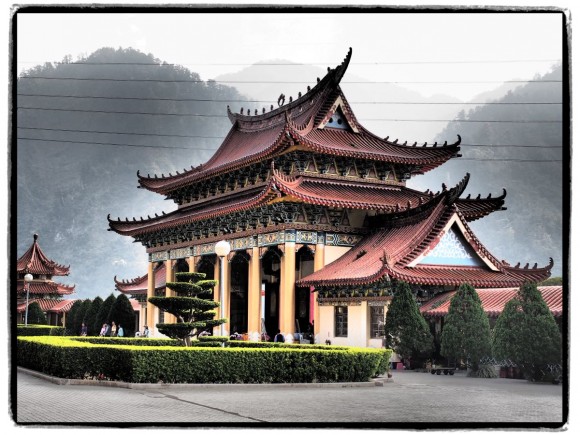Day 5 & 6 CNY Scooter Trip 2013
Day 5&6
Friday February 15, 2013
9:15 a.m. Guguan on the Central Cross-Island Highway
I woke up fairly early when I left from Taichung considering everything, and then I packed up my sleeping bag and sleeping mat and backpack. I hung out in my friend’s living room for a little bit and had a cup of coffee. Then just as I was getting ready to leave and making sure I had everything, I realized that I had mislaid my bungee cords – the cords that I used to strap my backpack and tent to my scooter. Without those, I thought I was kind of stuck. I looked everywhere and I couldn’t find them. I thought back and I came to the conclusion that I must have left them outside when I arrived. I have a vague memory of unstrapping my backpack and camping gear and laying the bungee cords over another scooter parked beside mine. Then I must have picked up all my gear and gone into the apartment and simply left the bungee cords there. That is very unlike me, but it is the only explanation. And even though it is unlike me, it is still possible. When I first go on a trip like this, it takes a little while to get into the rhythm of things and it’s easy to leave things behind or make mistakes.
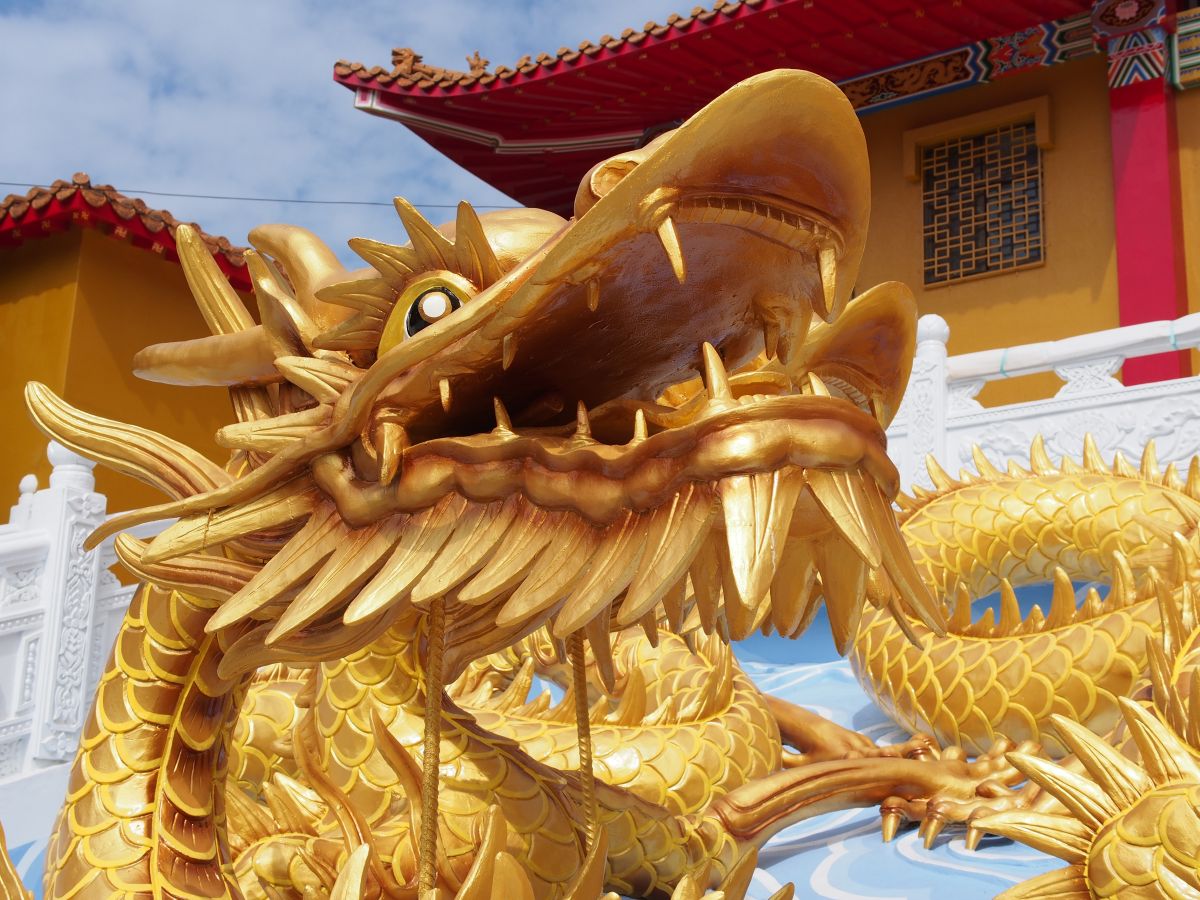 Everything worked out in the end, though. When I left from the apartment, I just put my backpack and tent and sleeping pad on the floor of the scooter and I put my big knapsack on my back. It wasn’t comfortable or particularly safe, but it was workable and I slowly navigated my way out of Taichung. THAT wasn’t easy. Again, it was very unlike me, but I never got oriented while in Taichung. I think it was because I was just following instructions all the time and not doing any navigating of my own. So I never really knew where I was. I kept getting turned around. Plus, Taiwan’s streets are very confusing and they have a very irregular system for naming roads. The same road can have ten different names. The names seem to change at every intersection, making it impossible to find your way.
Everything worked out in the end, though. When I left from the apartment, I just put my backpack and tent and sleeping pad on the floor of the scooter and I put my big knapsack on my back. It wasn’t comfortable or particularly safe, but it was workable and I slowly navigated my way out of Taichung. THAT wasn’t easy. Again, it was very unlike me, but I never got oriented while in Taichung. I think it was because I was just following instructions all the time and not doing any navigating of my own. So I never really knew where I was. I kept getting turned around. Plus, Taiwan’s streets are very confusing and they have a very irregular system for naming roads. The same road can have ten different names. The names seem to change at every intersection, making it impossible to find your way.
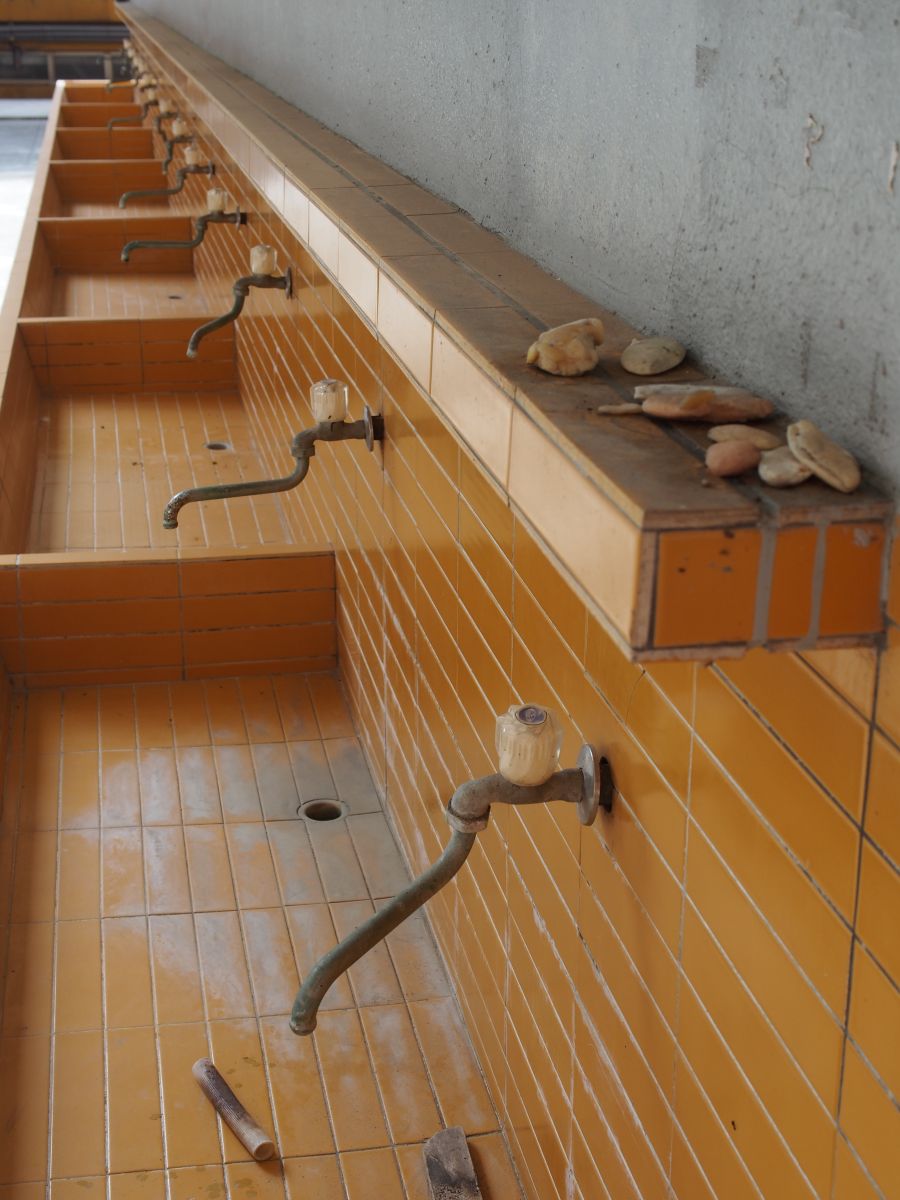 Still, I had sat down with all my maps and carefully plotted the easiest route out of Taichung and into the mountains to the west. I stopped many times to pull out my map and make sure I was still on track. I also kept half an eye out for any kind store that might sell bungee cords or rope or straps. And to my delight, I spotted a huge hardware store with the letters DIY blazing on top in a big sign. It seemed perfect. I parked my scooter and went inside and found a big display of bungee cords of different lengths. I had done some measuring and I knew what length I wanted, but they didn’t have that length. No matter, though. I bought two 10-foot bungee cords for about one dollar each. They were far too long, but that was better than too short. I took them outside and then wrapped them around my backpack four or five times and got everything securely strapped to the back of my scooter.
Still, I had sat down with all my maps and carefully plotted the easiest route out of Taichung and into the mountains to the west. I stopped many times to pull out my map and make sure I was still on track. I also kept half an eye out for any kind store that might sell bungee cords or rope or straps. And to my delight, I spotted a huge hardware store with the letters DIY blazing on top in a big sign. It seemed perfect. I parked my scooter and went inside and found a big display of bungee cords of different lengths. I had done some measuring and I knew what length I wanted, but they didn’t have that length. No matter, though. I bought two 10-foot bungee cords for about one dollar each. They were far too long, but that was better than too short. I took them outside and then wrapped them around my backpack four or five times and got everything securely strapped to the back of my scooter.
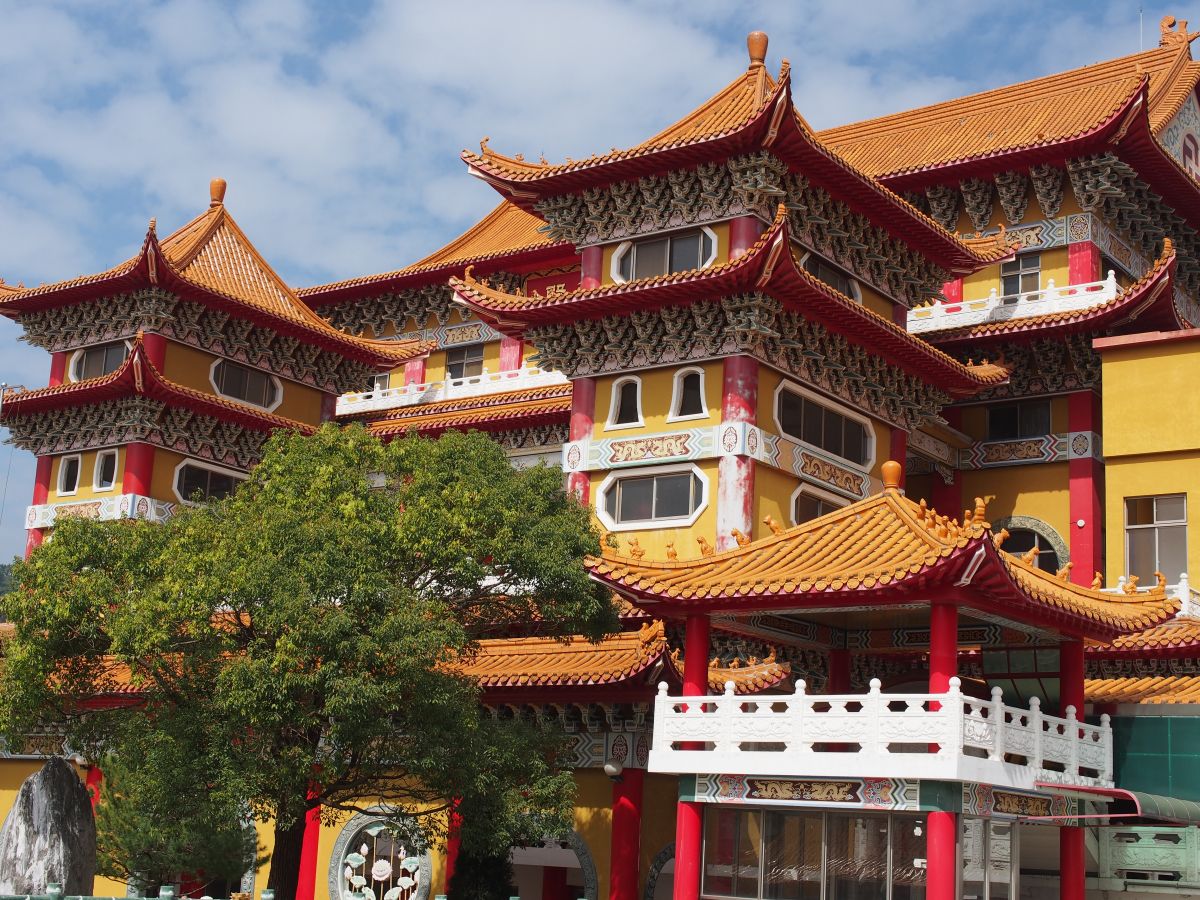 A few minutes later still stopping at every corner for a map check, I found myself on the outskirts of Taichung and breathing easier. I was nice to be back out into the more relaxing countryside. I stopped at a huge 7-11 along the way and had a breakfast of very spicy tofu with rice. It’s one of my favorite meals – made with red chilies. You can get some surprisingly good meals at 7-11.
A few minutes later still stopping at every corner for a map check, I found myself on the outskirts of Taichung and breathing easier. I was nice to be back out into the more relaxing countryside. I stopped at a huge 7-11 along the way and had a breakfast of very spicy tofu with rice. It’s one of my favorite meals – made with red chilies. You can get some surprisingly good meals at 7-11.
While I was there having breakfast, I realized that I was in a very popular recreational area. Lots of people from Taichung on bicycles and motorcycles were passing by and also stopping at this 7-11 on their way into the mountains for a day trip. Cycling is a very popular hobby here at the moment, and the Taiwanese never do anything halfway. They don’t just grab the bicycle from their garage and go for a ride. They buy the latest and most expensive bicycle they can find and then deck themselves out in high-tech cycling gear from head to toe. It always seems a bit much to me, but it’s a natural thing for the Taiwanese. They love to look the part of whatever they are doing and are very comfortable in uniforms. So they put on that skintight Lycra and wear special cycling shoes and get cycling glasses and everything else you can name. It looks very uncomfortable to me and highly unnecessary, but I guess it’s fun if you’re into that sort of thing. I prefer to be low key. I just wear whatever clothes I would wear while doing anything else. I’m sure they look at me and think that I’m quite weird to be riding a bicycle or even a scooter in just a pair of khaki pants and my regular shoes. It generally comes down to the age-old idea of form vs. function. I’m all about function. I don’t care what something looks like. I only need it to work. The Taiwanese personality tends to go for form over anything else. Things have to look right regardless of whether it makes any sense or even works.
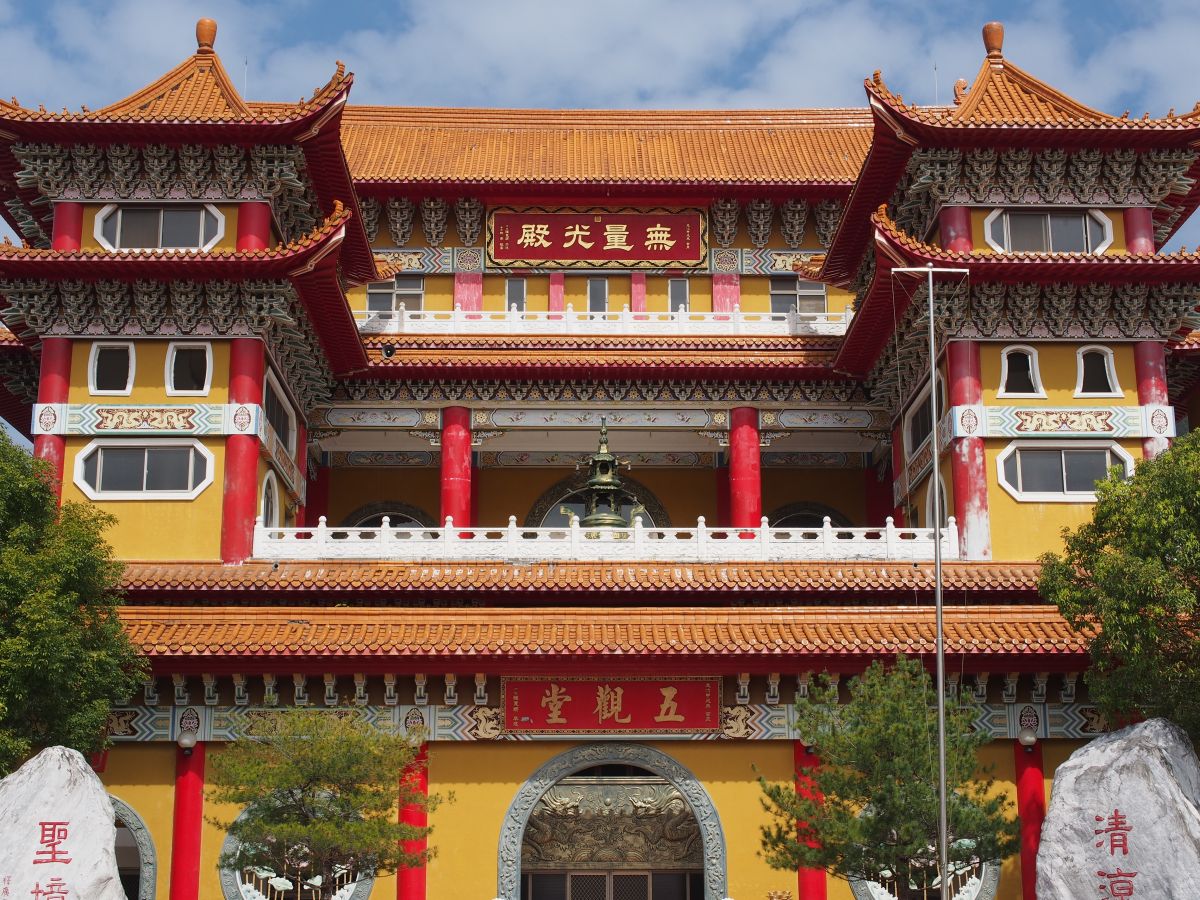 You certainly see contrasts in Taiwan, perhaps many more contrasts than you would see in a country like Canada. In this 7-11, a monk was sitting at the table beside mine. He was wearing a plain gray robe that stretched from shoulders to ankles. On his feet were traditional Chinese sandals and these yellowish roughly-made socks that I see on all the monks. His head was shaved and he was eating plain white bread and vegetable juice. At the table next to him sat a group of cyclists the most extreme of which was a woman with layer upon layer of neon-colored cycling gear. Women here are terrified of the sun, and when they go out cycling they cover every square inch of skin. Nothing is exposed. They look like some kind of creature from another world with all the bright Lycra and kerchiefs and hats and helmets and face masks and elbow length gloves. This woman had two or three kerchiefs arranged around her head and neck to cover all the skin there. On top of that she had placed a hat with a wide brim to add extra sun protection. And on top of that she had placed a state-of-the-art cycling helmet – one of those pointy swept-back things with high-tech lines and bulging aerodynamic shapes. Yet, she had so many layers on her head that this helmet was perched way up high and certainly offering no real protection at all in terms of a crash. But that wouldn’t matter to her. The function of the helmet was not important. It was the very fact that she was wearing a cycling helmet and not just any cycling helmet but the most high-tech and expensive model she could find. This cyclist and all her cycling friends represented consumerism gone mad and the monk represented a simple minimalism. And they could probably switch places easily. The monk could cease being a monk some year and then he, too, would just put on a different uniform.
You certainly see contrasts in Taiwan, perhaps many more contrasts than you would see in a country like Canada. In this 7-11, a monk was sitting at the table beside mine. He was wearing a plain gray robe that stretched from shoulders to ankles. On his feet were traditional Chinese sandals and these yellowish roughly-made socks that I see on all the monks. His head was shaved and he was eating plain white bread and vegetable juice. At the table next to him sat a group of cyclists the most extreme of which was a woman with layer upon layer of neon-colored cycling gear. Women here are terrified of the sun, and when they go out cycling they cover every square inch of skin. Nothing is exposed. They look like some kind of creature from another world with all the bright Lycra and kerchiefs and hats and helmets and face masks and elbow length gloves. This woman had two or three kerchiefs arranged around her head and neck to cover all the skin there. On top of that she had placed a hat with a wide brim to add extra sun protection. And on top of that she had placed a state-of-the-art cycling helmet – one of those pointy swept-back things with high-tech lines and bulging aerodynamic shapes. Yet, she had so many layers on her head that this helmet was perched way up high and certainly offering no real protection at all in terms of a crash. But that wouldn’t matter to her. The function of the helmet was not important. It was the very fact that she was wearing a cycling helmet and not just any cycling helmet but the most high-tech and expensive model she could find. This cyclist and all her cycling friends represented consumerism gone mad and the monk represented a simple minimalism. And they could probably switch places easily. The monk could cease being a monk some year and then he, too, would just put on a different uniform.
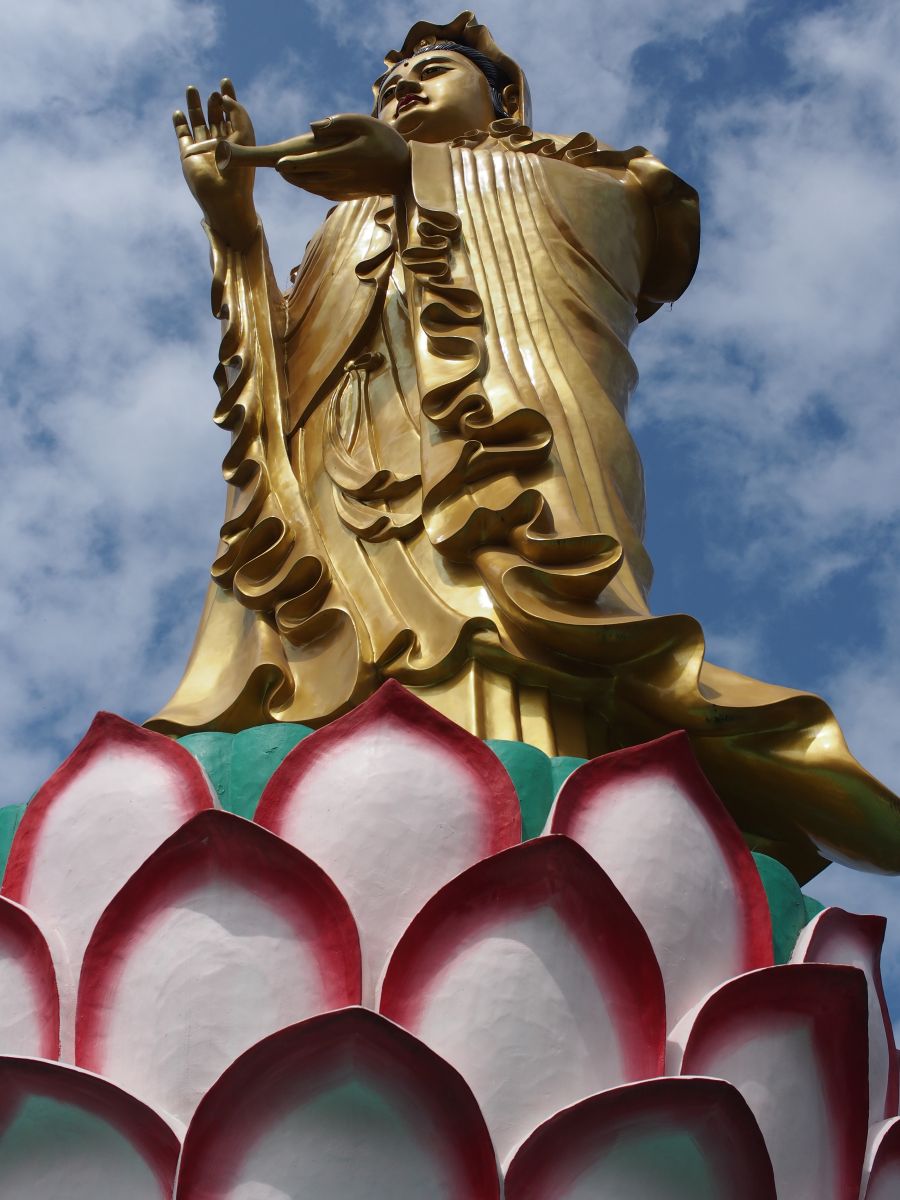 Once I left the 7-11, I was in the mountains proper and really began to enjoy the drive. I find that the smaller the road, the more interesting the drive and I always look for the smallest road I can on my maps. Other roads might be more direct, but they pass through fewer mountains and they generally have more traffic. I had plotted a route down some local small roads and the scenery was beautiful. My first stop was at a temple.
Once I left the 7-11, I was in the mountains proper and really began to enjoy the drive. I find that the smaller the road, the more interesting the drive and I always look for the smallest road I can on my maps. Other roads might be more direct, but they pass through fewer mountains and they generally have more traffic. I had plotted a route down some local small roads and the scenery was beautiful. My first stop was at a temple.
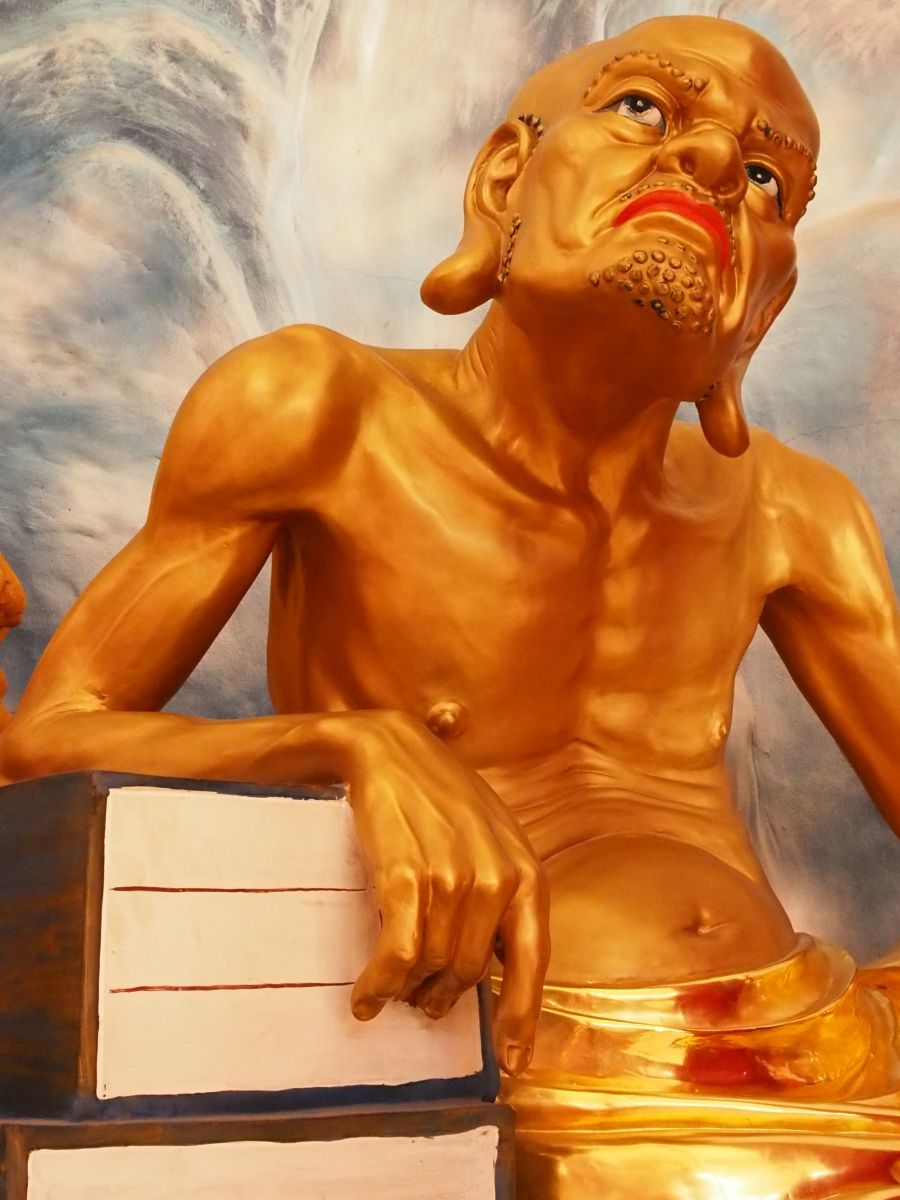 From the road, the temple looked large enough to be interesting, but I had no idea how big it was until I went into the front gates and into the complex itself. It was massive with seemingly no end to the buildings. Buddhist and Taoist and Confucian temples are, of course, quite different from a Christian church. Churches are built around the idea of everyone sitting together in a big room and listening to sermons. Buddhists don’t have any kinds of traditions like that, so there are no large rooms with long pews and that sort of thing. For that reason, they tend to be more outdoor places. The centerpiece of a Buddhist temple is always the large statues – some of them extremely large – of Bhudda or the many, many deities. Taiwanese Buddhism is really quite eclectic and they cheerfully accept all kinds of additions in the way of gods. There are so many deities that no one could possibly keep track of them all. Most temples, though, will be primarily dedicated to one particular deity. There will be a very large statue of that god in the center of the temple. They are always inside a kind of building with a roof over their heads. It might be a larger enclosed area or quite a small one. And there will be a big open courtyard in front of the statue with an incense burner, tables for offerings, and that sort of thing. There will be large musical instruments like drums and all manner of things used for asking for things and seeing what kind of answer you get to your request. The basic idea of Buddhism, is, of course, one of karma and reincarnation – that good deeds in this lifetime will lead to your being born again at a higher level. Do that long enough and enough times and you reach nirvana. Bad deeds will lead to being reincarnated at a lower level. However, my sense is that the average person does not practice Buddhism in the sense of doing good deeds. They go to the temples to ask for things from the gods. If they are sick, they will go to a temple dedicated to the god of health and make an offering there to ask for good health. If they are preparing for a big exam at school, they will go to a temple dedicated to education. If they want success in business, they will go to the god of wealth. And on and on. I could be wrong, but that seems to be the pattern – to visit temples to ask for good fortune for yourself and your family members. Ancestors are a big part of this, and they can bestow blessings themselves or act as intermediaries between you and the gods. Therefore, it’s very important to keep your ancestors happy and there are many traditions for that – things like burning ghost money so that your ancestors can have money in the afterlife. You offer food so that they don’t go hungry. In modern times, this has been extended to all manner of things. These are generally paper things that are then burned in order to offer them. People now will burn paper cars and other luxury items so that their ancestors will have these things. Whether people actually believe this is true or not is open to question. Most people here don’t seem to sweat it that much. You do these things because it is what you do and you don’t think about it too hard or too logically. That they take it seriously, though, is beyond question. The number and scale of the temples in Taiwan is extraordinary. And on special days for the temples, people will come in their thousands and tens of thousands for rituals and processions. It is a big part of life here.
From the road, the temple looked large enough to be interesting, but I had no idea how big it was until I went into the front gates and into the complex itself. It was massive with seemingly no end to the buildings. Buddhist and Taoist and Confucian temples are, of course, quite different from a Christian church. Churches are built around the idea of everyone sitting together in a big room and listening to sermons. Buddhists don’t have any kinds of traditions like that, so there are no large rooms with long pews and that sort of thing. For that reason, they tend to be more outdoor places. The centerpiece of a Buddhist temple is always the large statues – some of them extremely large – of Bhudda or the many, many deities. Taiwanese Buddhism is really quite eclectic and they cheerfully accept all kinds of additions in the way of gods. There are so many deities that no one could possibly keep track of them all. Most temples, though, will be primarily dedicated to one particular deity. There will be a very large statue of that god in the center of the temple. They are always inside a kind of building with a roof over their heads. It might be a larger enclosed area or quite a small one. And there will be a big open courtyard in front of the statue with an incense burner, tables for offerings, and that sort of thing. There will be large musical instruments like drums and all manner of things used for asking for things and seeing what kind of answer you get to your request. The basic idea of Buddhism, is, of course, one of karma and reincarnation – that good deeds in this lifetime will lead to your being born again at a higher level. Do that long enough and enough times and you reach nirvana. Bad deeds will lead to being reincarnated at a lower level. However, my sense is that the average person does not practice Buddhism in the sense of doing good deeds. They go to the temples to ask for things from the gods. If they are sick, they will go to a temple dedicated to the god of health and make an offering there to ask for good health. If they are preparing for a big exam at school, they will go to a temple dedicated to education. If they want success in business, they will go to the god of wealth. And on and on. I could be wrong, but that seems to be the pattern – to visit temples to ask for good fortune for yourself and your family members. Ancestors are a big part of this, and they can bestow blessings themselves or act as intermediaries between you and the gods. Therefore, it’s very important to keep your ancestors happy and there are many traditions for that – things like burning ghost money so that your ancestors can have money in the afterlife. You offer food so that they don’t go hungry. In modern times, this has been extended to all manner of things. These are generally paper things that are then burned in order to offer them. People now will burn paper cars and other luxury items so that their ancestors will have these things. Whether people actually believe this is true or not is open to question. Most people here don’t seem to sweat it that much. You do these things because it is what you do and you don’t think about it too hard or too logically. That they take it seriously, though, is beyond question. The number and scale of the temples in Taiwan is extraordinary. And on special days for the temples, people will come in their thousands and tens of thousands for rituals and processions. It is a big part of life here.
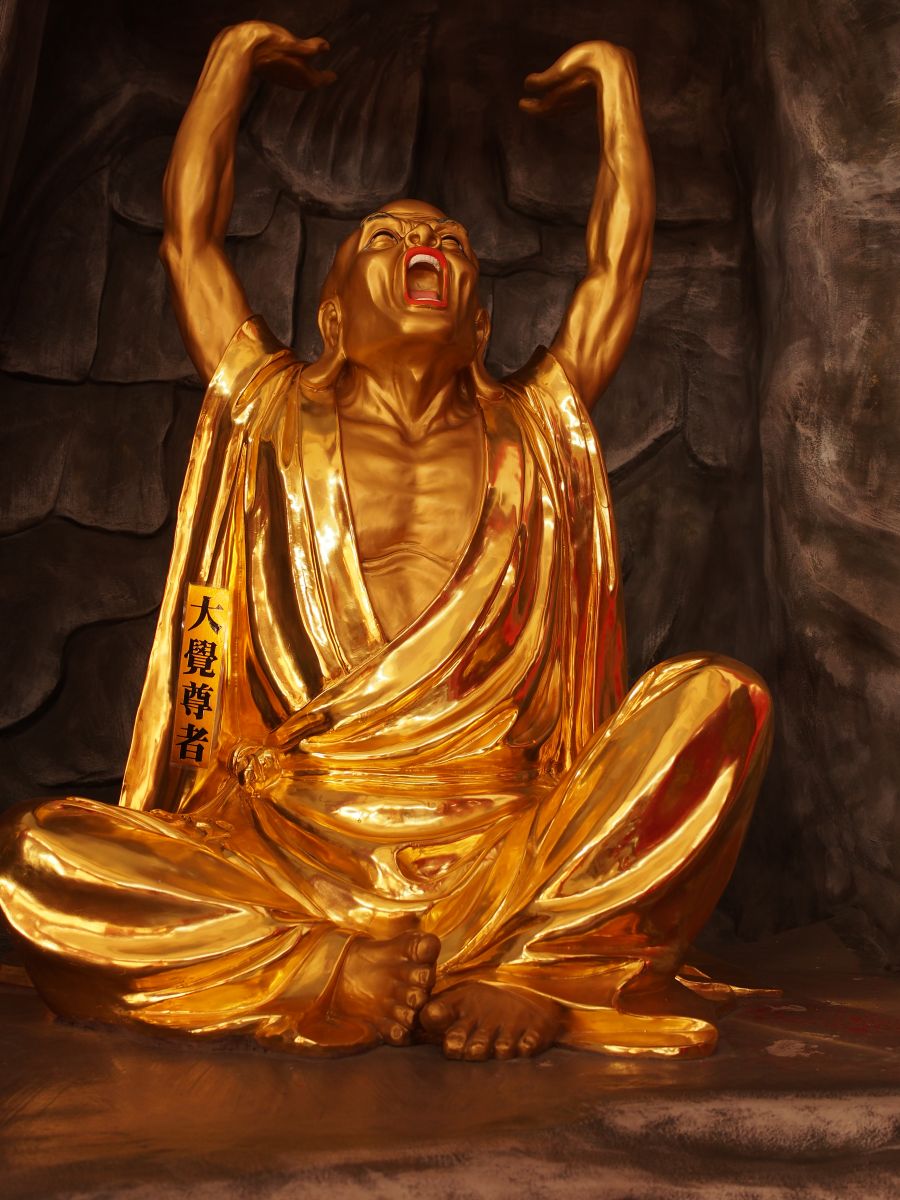
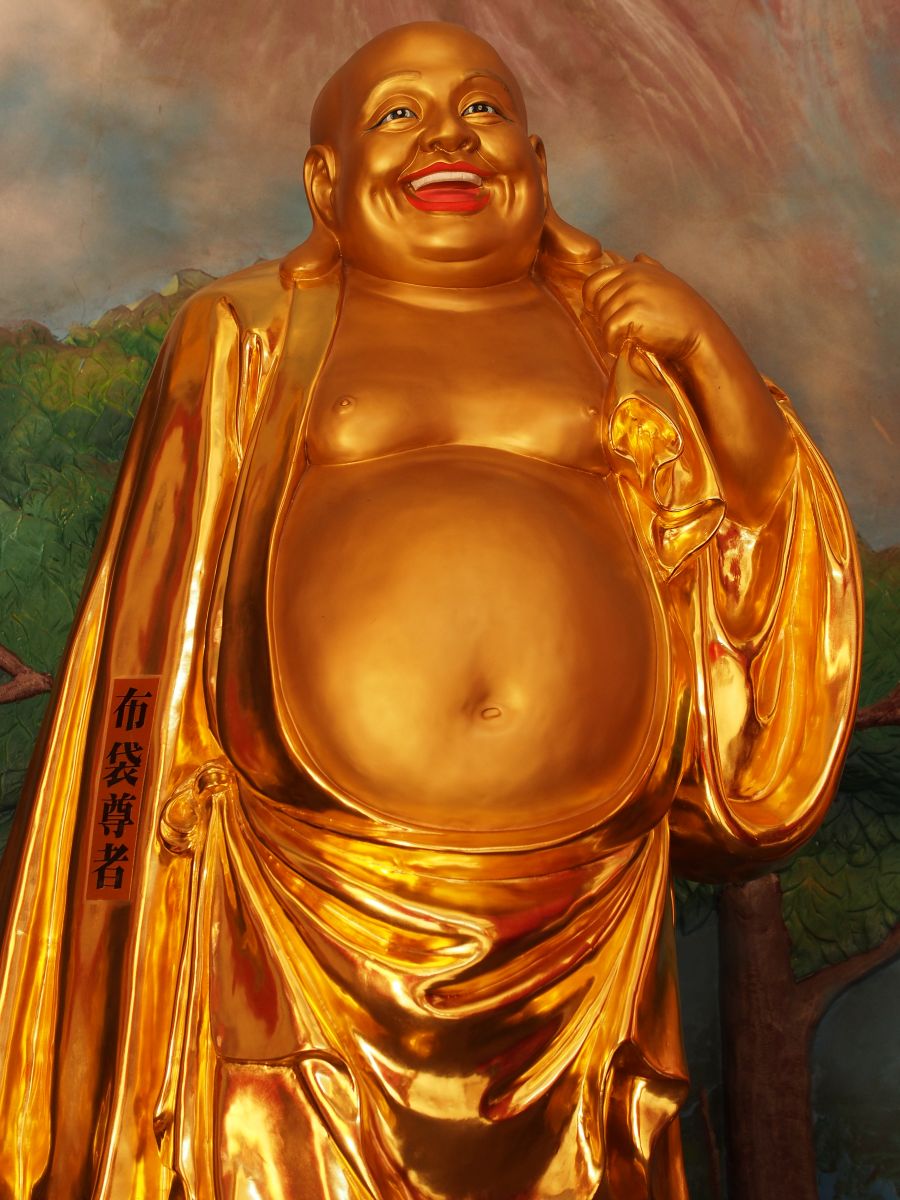
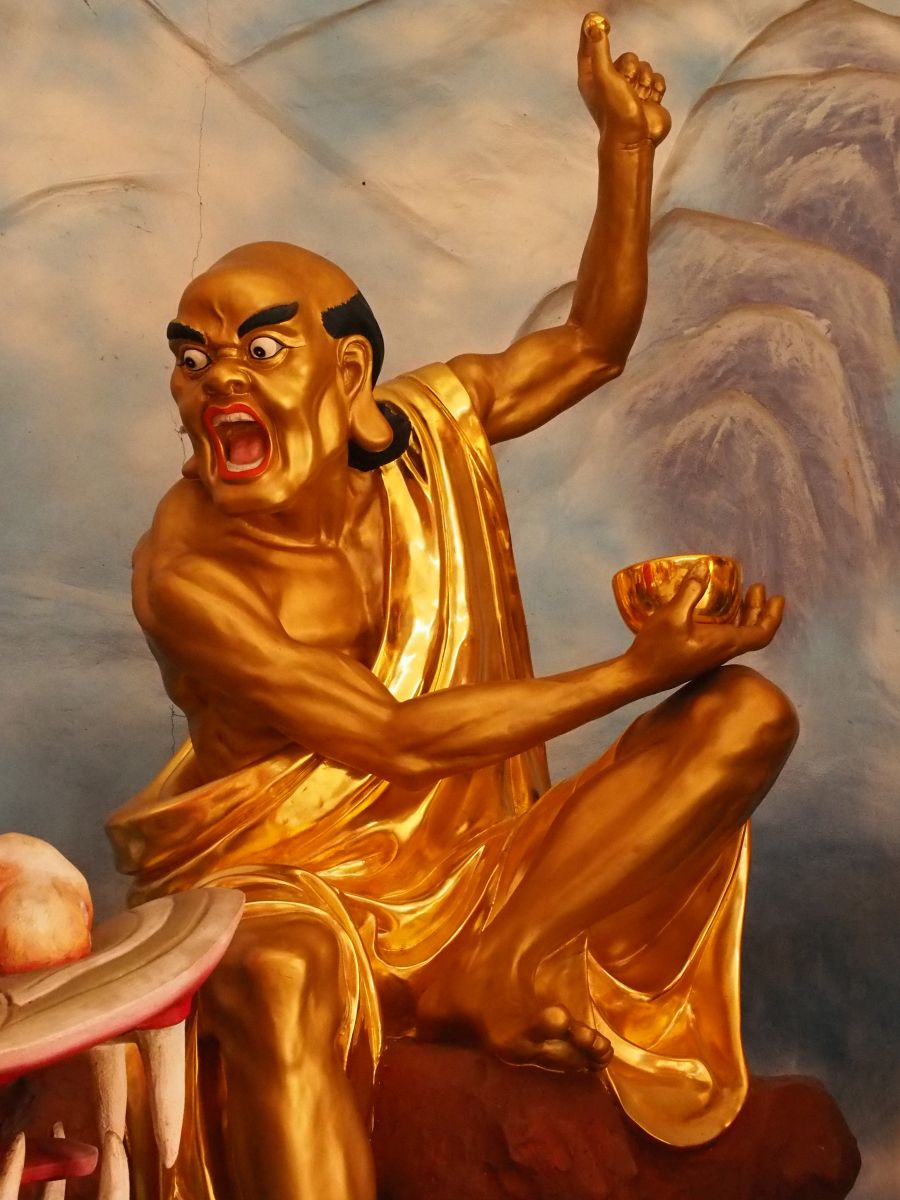 I’m not sure to what extent the temples represent a sense of community, though. This idea of community is a big part of Christian churches. I think it’s one of the most valuable things. Churches have a membership and everyone knows the other members and they all take care of each other. Temples in Taiwan don’t seem to be like that. As I mentioned, there is no time at which all people get together in a big room. I don’t think there is a membership roll or registry or anything like that. They’re complicated in the way they operate and have a very vibrant financial life. People donate vast sums to the temples. Temples also make money through people buying incense and ghost money and other offerings. I’ve heard that some temples are, in fact, privately owned and produce quite a profit for their owners. To that extent, they are run almost like a business. Others are more public in nature. Monks live at the temples and maintain them and study there and perform all the rituals and processions. But how all that works is far beyond me. I think even if you lived at one of these temples, it would take a long time to figure out how it all works.
I’m not sure to what extent the temples represent a sense of community, though. This idea of community is a big part of Christian churches. I think it’s one of the most valuable things. Churches have a membership and everyone knows the other members and they all take care of each other. Temples in Taiwan don’t seem to be like that. As I mentioned, there is no time at which all people get together in a big room. I don’t think there is a membership roll or registry or anything like that. They’re complicated in the way they operate and have a very vibrant financial life. People donate vast sums to the temples. Temples also make money through people buying incense and ghost money and other offerings. I’ve heard that some temples are, in fact, privately owned and produce quite a profit for their owners. To that extent, they are run almost like a business. Others are more public in nature. Monks live at the temples and maintain them and study there and perform all the rituals and processions. But how all that works is far beyond me. I think even if you lived at one of these temples, it would take a long time to figure out how it all works.
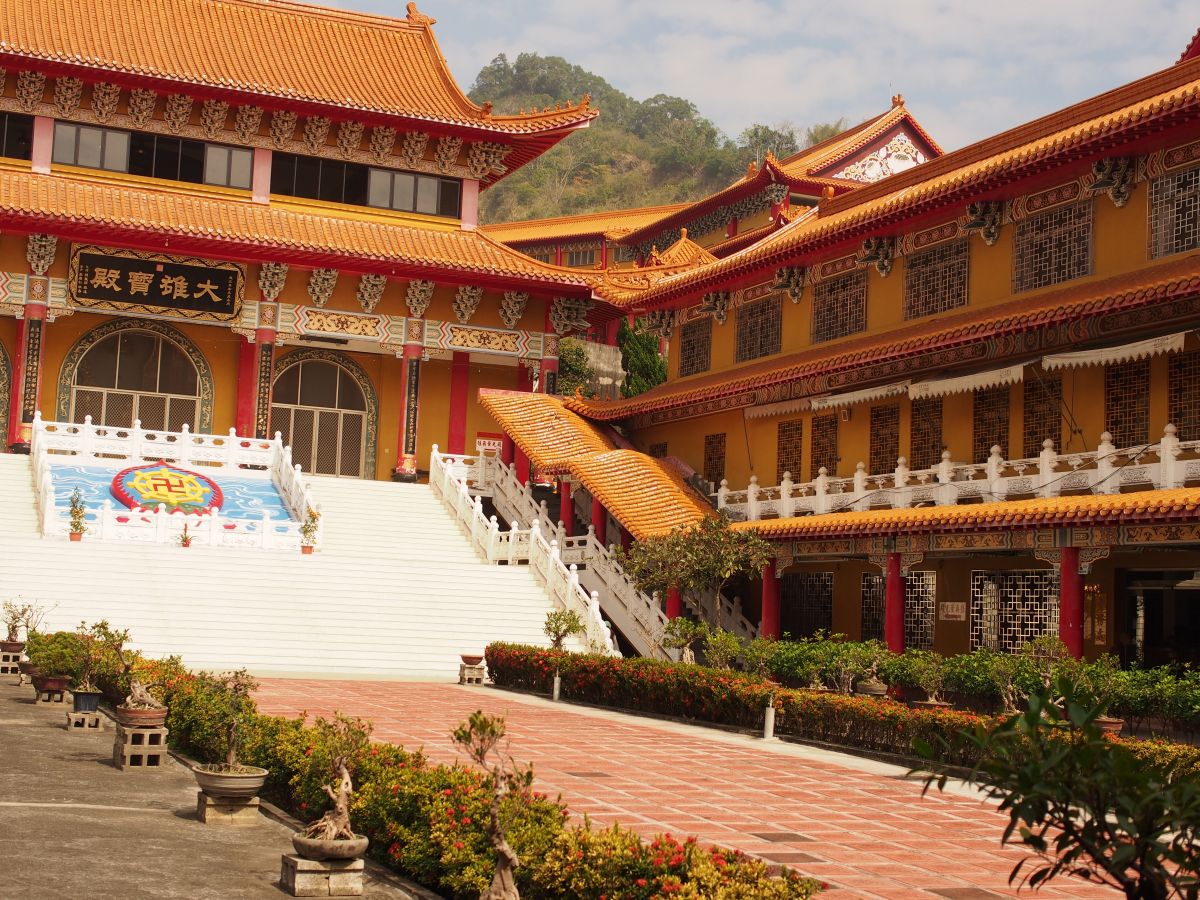 Temples are on my mind, I guess, because I spent two nights at the temple complex in Miaoli. And last night after visiting this one huge temple, I drove down the central cross-island highway and stumbled across another very large temple. It is near the town of Guguan and is called the Great Guguan Temple or something like that. It was quite different from the other temples I’d seen on this trip. I can’t say for sure how it was different. It looked different in that it was far less ornate. Most temples here are gaudy in the extreme and have bright colors and statues and engravings everywhere. They’re like massive wedding cakes gone insane. This temple was much more subdued and simple. The roofline was not dominated by fantastic creatures in many colors. The courtyard area was clean and simple with elegant trees sculpted in the Japanese fashion of banzai trees. There were the usual large statues as the centerpiece, but there were far fewer smaller statues and much less decoration.
Temples are on my mind, I guess, because I spent two nights at the temple complex in Miaoli. And last night after visiting this one huge temple, I drove down the central cross-island highway and stumbled across another very large temple. It is near the town of Guguan and is called the Great Guguan Temple or something like that. It was quite different from the other temples I’d seen on this trip. I can’t say for sure how it was different. It looked different in that it was far less ornate. Most temples here are gaudy in the extreme and have bright colors and statues and engravings everywhere. They’re like massive wedding cakes gone insane. This temple was much more subdued and simple. The roofline was not dominated by fantastic creatures in many colors. The courtyard area was clean and simple with elegant trees sculpted in the Japanese fashion of banzai trees. There were the usual large statues as the centerpiece, but there were far fewer smaller statues and much less decoration.
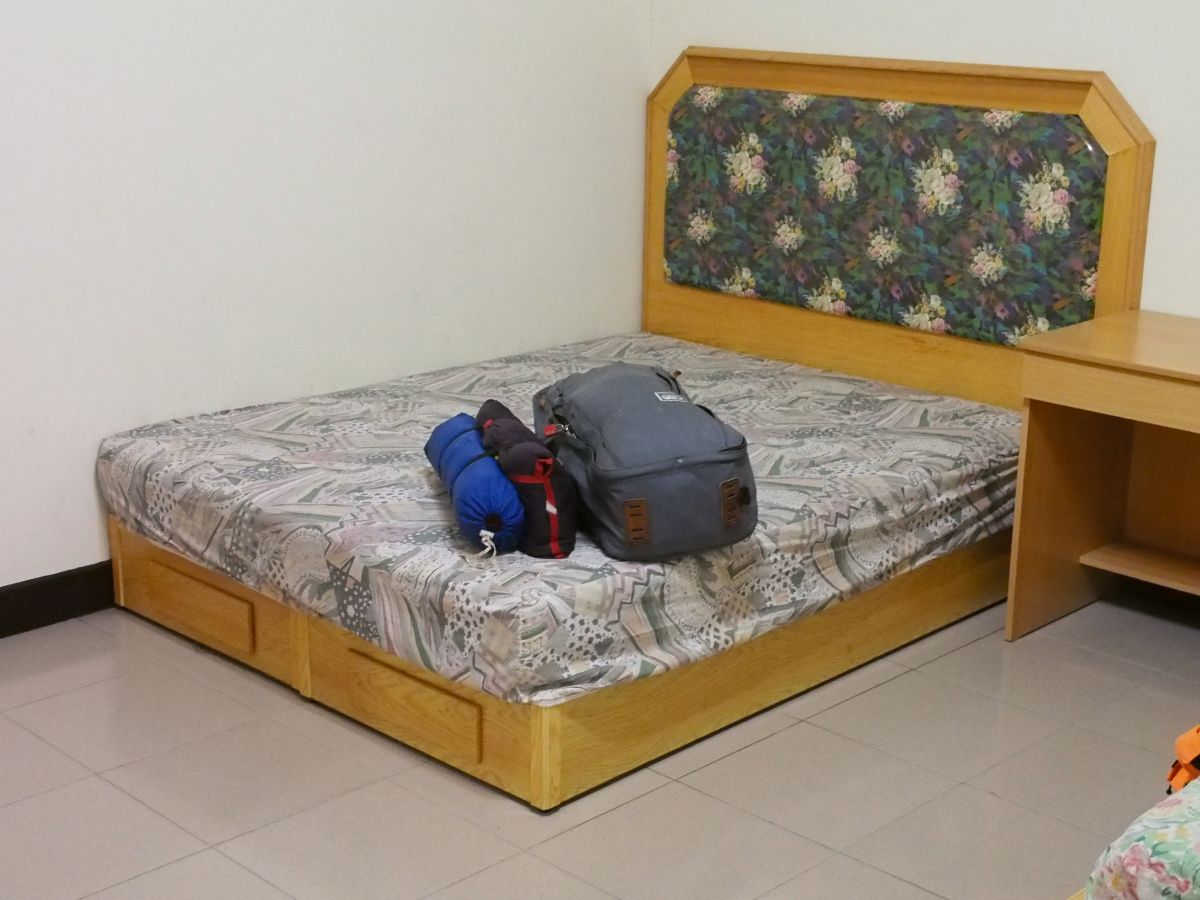 It also seemed to be a much more spiritual kind of place with its own style and rituals. When I arrived near the main gates, a procession was coming out. I knew something was going on when a young boy ran past me and laid out an immense line of firecrackers. He had an incense stick with him, but he didn’t light the fuse right away. He was clearly waiting for something. Then I saw a procession emerging from the temple compound. It was a fairly small one with only twenty or thirty people, many dressed in matching yellow outfits. Some were carrying small statues and offering of food and other things. A fire had been lit in a big container outside the gate and as the people emerged from the gate, they held their statues and offerings over this fire as they passed. Many were dancing and swaying in ritualized ways. Some were even moving backwards. Others were vocalizing somehow with large guttural grunts from deep in their throats. It all seemed to be part of some special ritual, but I can’t even guess what it was about except that it was simply a purification rite. I believe the statues belonged to individuals and they had brought them to the temple from their homes. They probably paid a fee to the temple to have these monks and devotees carry them in a procession and bless and purify them in this fire. Then they would take them home for the year, probably to do it again next Chinese New Year.
It also seemed to be a much more spiritual kind of place with its own style and rituals. When I arrived near the main gates, a procession was coming out. I knew something was going on when a young boy ran past me and laid out an immense line of firecrackers. He had an incense stick with him, but he didn’t light the fuse right away. He was clearly waiting for something. Then I saw a procession emerging from the temple compound. It was a fairly small one with only twenty or thirty people, many dressed in matching yellow outfits. Some were carrying small statues and offering of food and other things. A fire had been lit in a big container outside the gate and as the people emerged from the gate, they held their statues and offerings over this fire as they passed. Many were dancing and swaying in ritualized ways. Some were even moving backwards. Others were vocalizing somehow with large guttural grunts from deep in their throats. It all seemed to be part of some special ritual, but I can’t even guess what it was about except that it was simply a purification rite. I believe the statues belonged to individuals and they had brought them to the temple from their homes. They probably paid a fee to the temple to have these monks and devotees carry them in a procession and bless and purify them in this fire. Then they would take them home for the year, probably to do it again next Chinese New Year.
When the first people reached the fire, the boy lit the firecrackers and ran away. It was a good thing he ran as far as he did because these were serious firecrackers – edging back up into the range of explosives rather than just firecrackers.
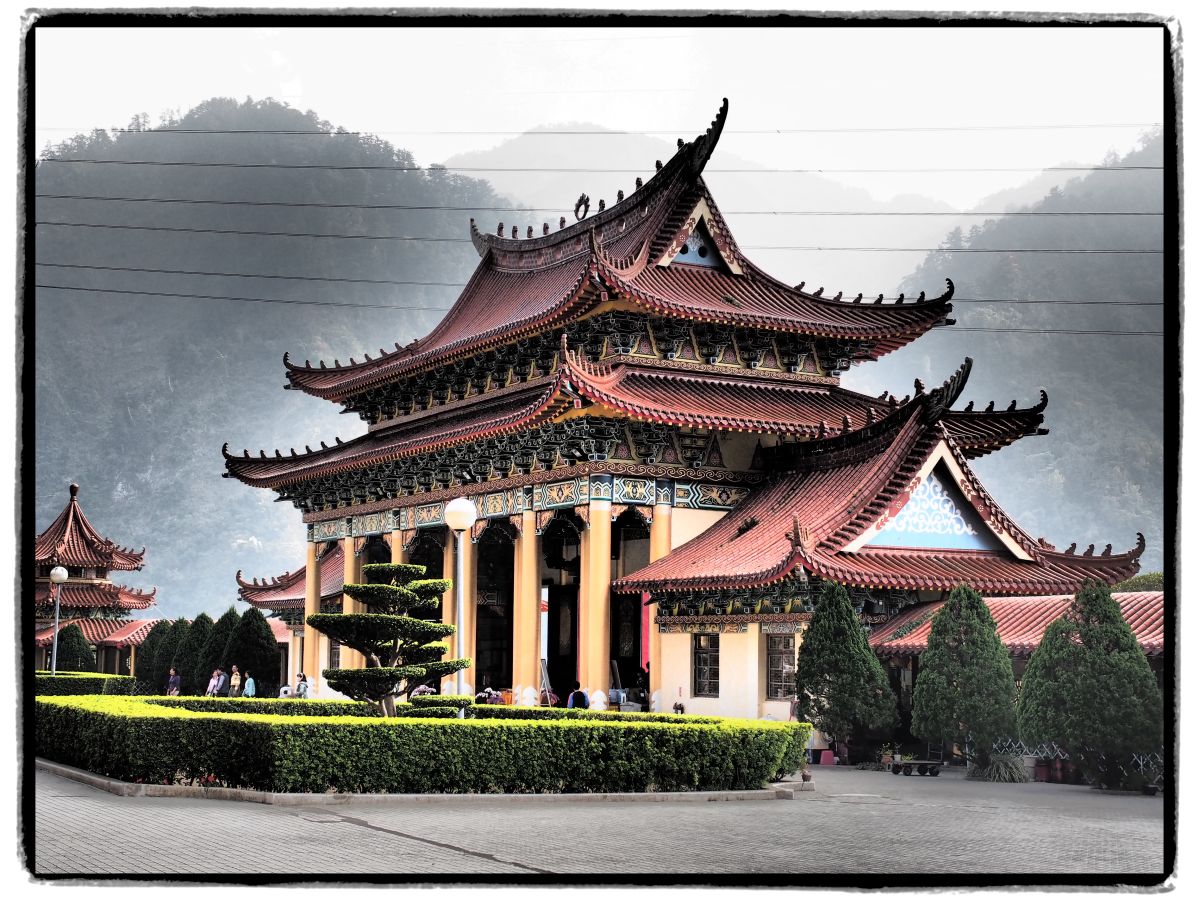 While I stood there watching the procession and absorbing it all, a man in a temple uniform started up a conversation. I asked him if it was possible to stay at the temple and to my delight, he said that they had many rooms open to visitors and that they were all free. They also had meals at certain times and everyone was welcome to join them. He brought me over to a large office and I signed a register and was handed the key to room 305. It was exactly like signing into a hotel in every way except that I was at a temple and I didn’t have to pay. The only wrinkle seemed to be that I was by myself. Taiwanese would rarely if ever go anywhere on their own. The temple would be more used to giving a room to a group of six or ten or twenty people. Figuring out how to assign a room to a single foreigner took a bit of effort. In the end, they gave me a western style room with two king-sized beds. The room was huge and if you brought in more mattresses, a good ten people could easily have stayed in it, but I had the whole thing to myself. All the fixtures appeared to be brand new and were of a much higher quality than I was used to. I wrote the other day of the Taiwanese tendency to buy the cheapest thing possible. This temple apparently had some money to spend because they bought high-quality stuff. Everything from the light fixtures to the showerheads and doors in the common bathroom were very well-made and built to last.
While I stood there watching the procession and absorbing it all, a man in a temple uniform started up a conversation. I asked him if it was possible to stay at the temple and to my delight, he said that they had many rooms open to visitors and that they were all free. They also had meals at certain times and everyone was welcome to join them. He brought me over to a large office and I signed a register and was handed the key to room 305. It was exactly like signing into a hotel in every way except that I was at a temple and I didn’t have to pay. The only wrinkle seemed to be that I was by myself. Taiwanese would rarely if ever go anywhere on their own. The temple would be more used to giving a room to a group of six or ten or twenty people. Figuring out how to assign a room to a single foreigner took a bit of effort. In the end, they gave me a western style room with two king-sized beds. The room was huge and if you brought in more mattresses, a good ten people could easily have stayed in it, but I had the whole thing to myself. All the fixtures appeared to be brand new and were of a much higher quality than I was used to. I wrote the other day of the Taiwanese tendency to buy the cheapest thing possible. This temple apparently had some money to spend because they bought high-quality stuff. Everything from the light fixtures to the showerheads and doors in the common bathroom were very well-made and built to last.
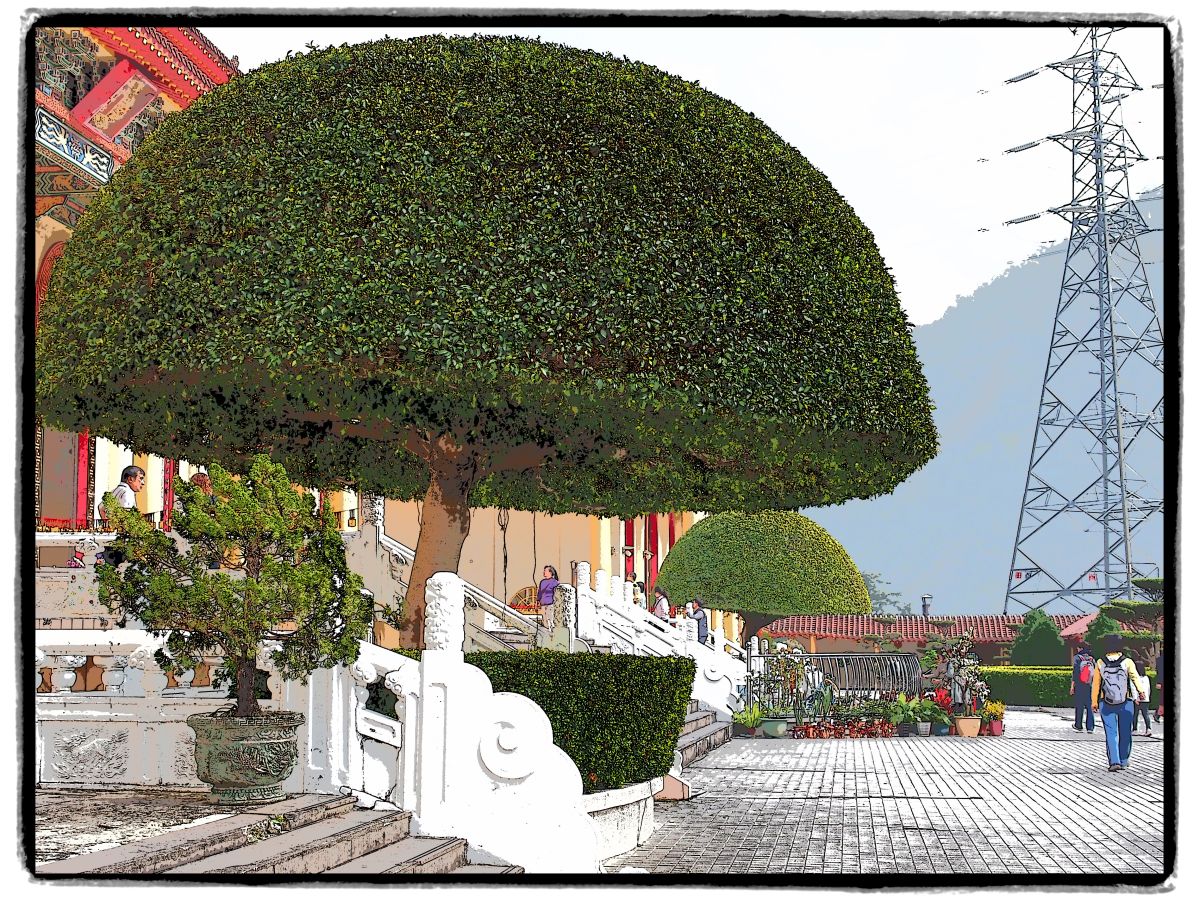 After I settled into my room, I went out into the temple courtyard with my camera. There, a man in his sixties and dressed in a suit and tie invited me over to another room for some tea and traditional Chinese snacks. He was some kind of temple official. He said his name was “Johnny”. He lived in a nearby town, but he spent a lot of time at the temple. He poured me some tea and served me a big plate of cut fruit and other snacks. He told me some of the history of the temple and even gave me two DVDs about the temple and showing the huge processions and events that happen there on August 8 each year.
After I settled into my room, I went out into the temple courtyard with my camera. There, a man in his sixties and dressed in a suit and tie invited me over to another room for some tea and traditional Chinese snacks. He was some kind of temple official. He said his name was “Johnny”. He lived in a nearby town, but he spent a lot of time at the temple. He poured me some tea and served me a big plate of cut fruit and other snacks. He told me some of the history of the temple and even gave me two DVDs about the temple and showing the huge processions and events that happen there on August 8 each year.
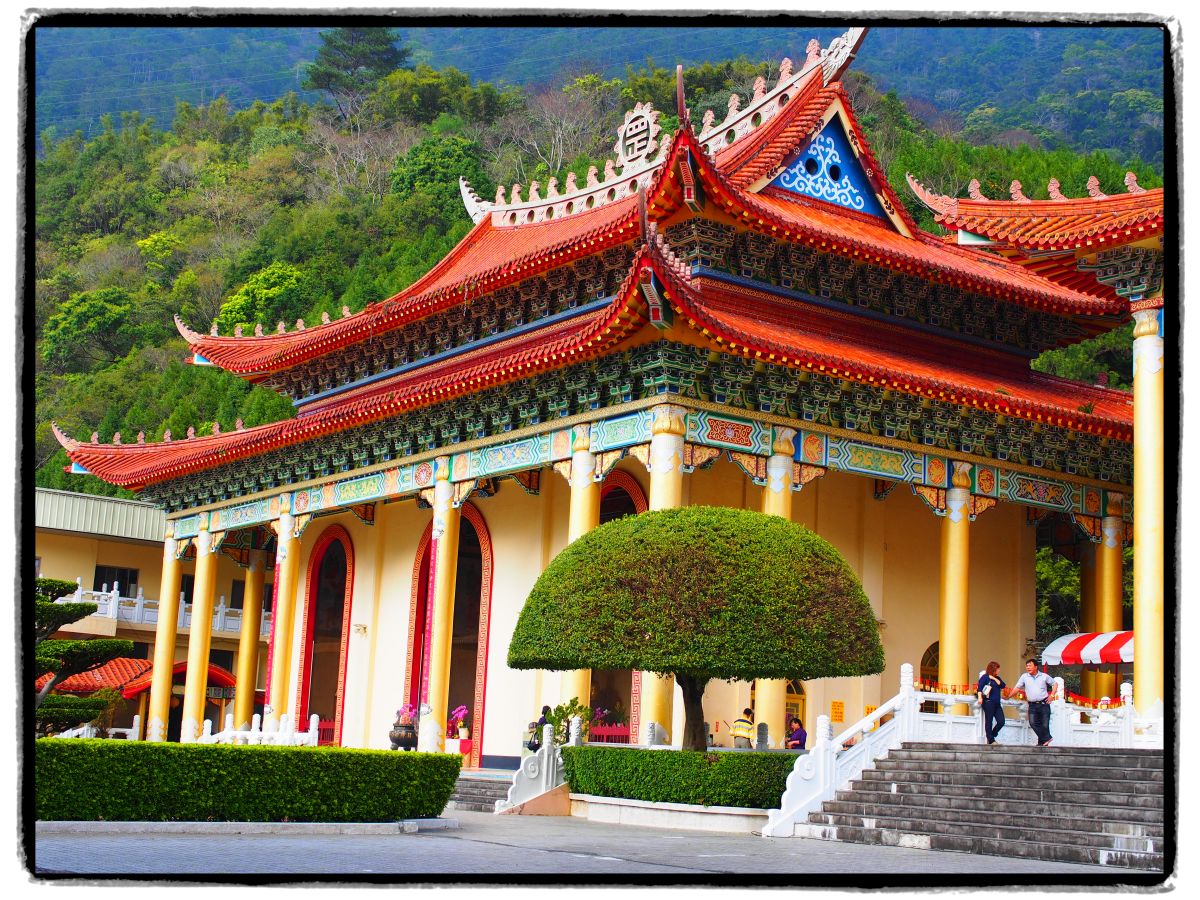 Johnny took me for a tour of the temple and explained a lot of things. Most interesting were two huge boulders. He showed me first a boulder that was sitting on the right side of the main temple building. It was maybe ten feet high and fifteen feet wide. Maybe bigger. He said that that boulder was there when the temple was built. It had probably been there for thousands of years. They had built a nice garden around it and it now is a centerpiece of the temple.
Johnny took me for a tour of the temple and explained a lot of things. Most interesting were two huge boulders. He showed me first a boulder that was sitting on the right side of the main temple building. It was maybe ten feet high and fifteen feet wide. Maybe bigger. He said that that boulder was there when the temple was built. It had probably been there for thousands of years. They had built a nice garden around it and it now is a centerpiece of the temple.
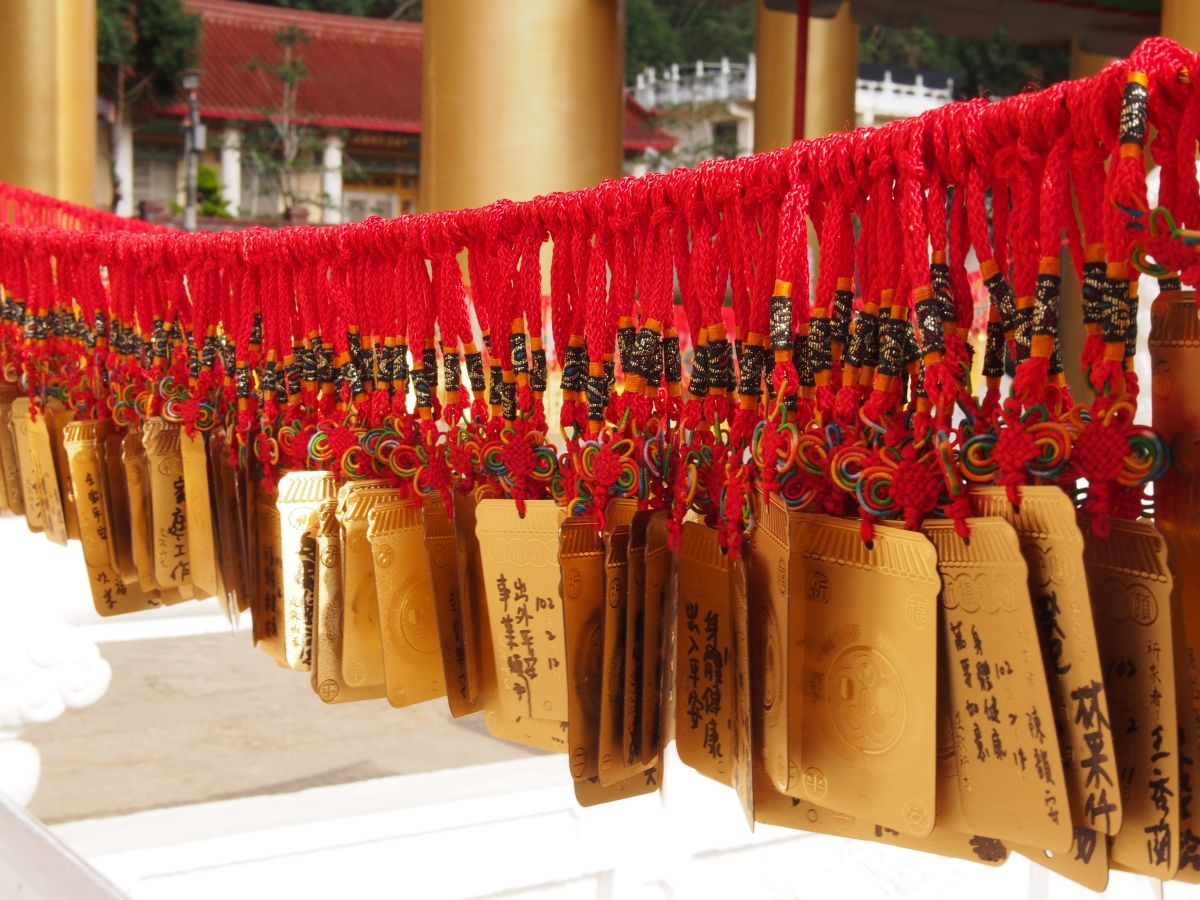 Then he took me to the left side of the temple and showed me a nearly identical boulder. This one, he said, had fallen from the mountain above about 12 years ago during a big earthquake. It was almost exactly the same size as the boulder on the right side. It was large enough that if it had hit the temple, it would likely have completely destroyed it. It certainly would have done a lot of damage. But, Johnny, told me, it missed the temple entirely and landed exactly where we saw it – sitting on the left side of the temple in perfect symmetry with the boulder on the right side. The point, of course, was that this was seen as a type of miracle – something that the gods of this temple had done deliberately. They had saved the temple from destruction and had placed the boulder to balance the boulder on the other side. It all seemed a little too perfect too me and Johnny was just vague enough on the details that I suspected that the true story was just a bit less perfect. My guess is that the boulder did fall from the mountains, but it didn’t fall in exactly that spot and that it was later moved. I suspected that mainly because there was a fairly large cement platform under the boulder. How would the cement have gotten there if the boulder fell there onto the ground? Plus, if that boulder had come down the mountainside just 12 years ago, I think there would still be some sign of its path and the destruction along the way. But there was none at all. Johnny was not bothered by these details, though, and I had to admit it made for a good story.
Then he took me to the left side of the temple and showed me a nearly identical boulder. This one, he said, had fallen from the mountain above about 12 years ago during a big earthquake. It was almost exactly the same size as the boulder on the right side. It was large enough that if it had hit the temple, it would likely have completely destroyed it. It certainly would have done a lot of damage. But, Johnny, told me, it missed the temple entirely and landed exactly where we saw it – sitting on the left side of the temple in perfect symmetry with the boulder on the right side. The point, of course, was that this was seen as a type of miracle – something that the gods of this temple had done deliberately. They had saved the temple from destruction and had placed the boulder to balance the boulder on the other side. It all seemed a little too perfect too me and Johnny was just vague enough on the details that I suspected that the true story was just a bit less perfect. My guess is that the boulder did fall from the mountains, but it didn’t fall in exactly that spot and that it was later moved. I suspected that mainly because there was a fairly large cement platform under the boulder. How would the cement have gotten there if the boulder fell there onto the ground? Plus, if that boulder had come down the mountainside just 12 years ago, I think there would still be some sign of its path and the destruction along the way. But there was none at all. Johnny was not bothered by these details, though, and I had to admit it made for a good story.
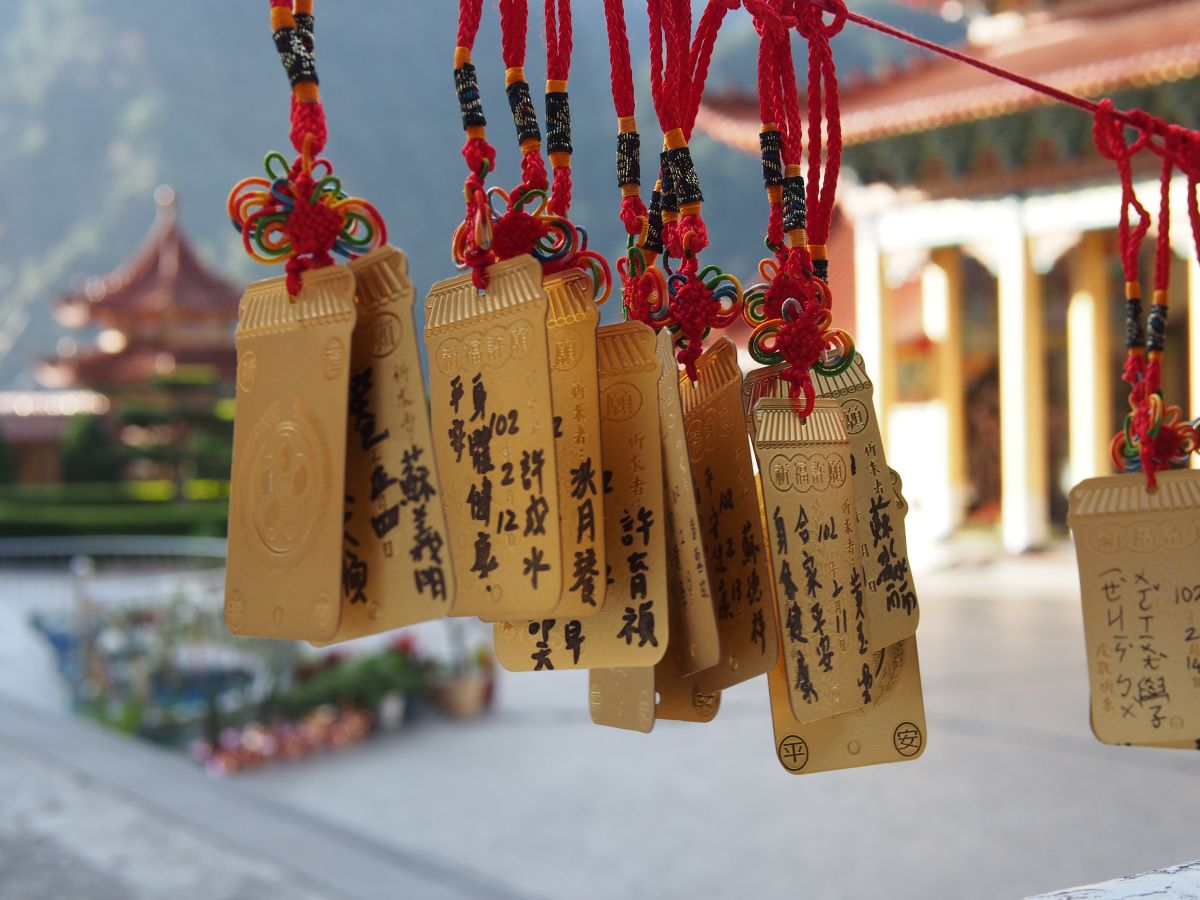 Johnny took me “behind the scenes” in some of the temple buildings and explained the meaning behind many of the things we saw. I knew all of that already, but I asked him questions to give him the pleasure of telling me about the place. He was clearly very proud of the temple and enjoyed showing it off. People often write wishes in one fashion or another at these temples and hang them up. They can be written on strips of wood or on decorative strips of paper with red string attached. They used the red paper here and Johnny told me all about them and then insisted that I write my own wish and hang it up. He said it was okay if I write in English. I obliged him and wished for good health and happiness for my brother and for my father and then I hung up the card alongside the hundreds of others to swing and blow in the wind outside the temple. I believe the wind is supposed to carry the wishes up to the gods. Then they loaded me up with some traditional Taiwanese fruit and I shook Johnny’s hand and said goodbye and thanks for the tour.
Johnny took me “behind the scenes” in some of the temple buildings and explained the meaning behind many of the things we saw. I knew all of that already, but I asked him questions to give him the pleasure of telling me about the place. He was clearly very proud of the temple and enjoyed showing it off. People often write wishes in one fashion or another at these temples and hang them up. They can be written on strips of wood or on decorative strips of paper with red string attached. They used the red paper here and Johnny told me all about them and then insisted that I write my own wish and hang it up. He said it was okay if I write in English. I obliged him and wished for good health and happiness for my brother and for my father and then I hung up the card alongside the hundreds of others to swing and blow in the wind outside the temple. I believe the wind is supposed to carry the wishes up to the gods. Then they loaded me up with some traditional Taiwanese fruit and I shook Johnny’s hand and said goodbye and thanks for the tour.
The sun was still up in the sky, and I hopped on my scooter to drive as far as I could into the mountains and explore the area. Guguan is the major town in this area and it is famous for its hot springs. Taiwanese come here to stay in spa hotels and soak in the hot water. To come here and NOT do that would be extraordinary to them, but I’ve never enjoyed just sitting in hot water. I get bored too quick and it seems like a lot of trouble just to take a bath. I’ve never liked baths, either. I’m a shower guy.
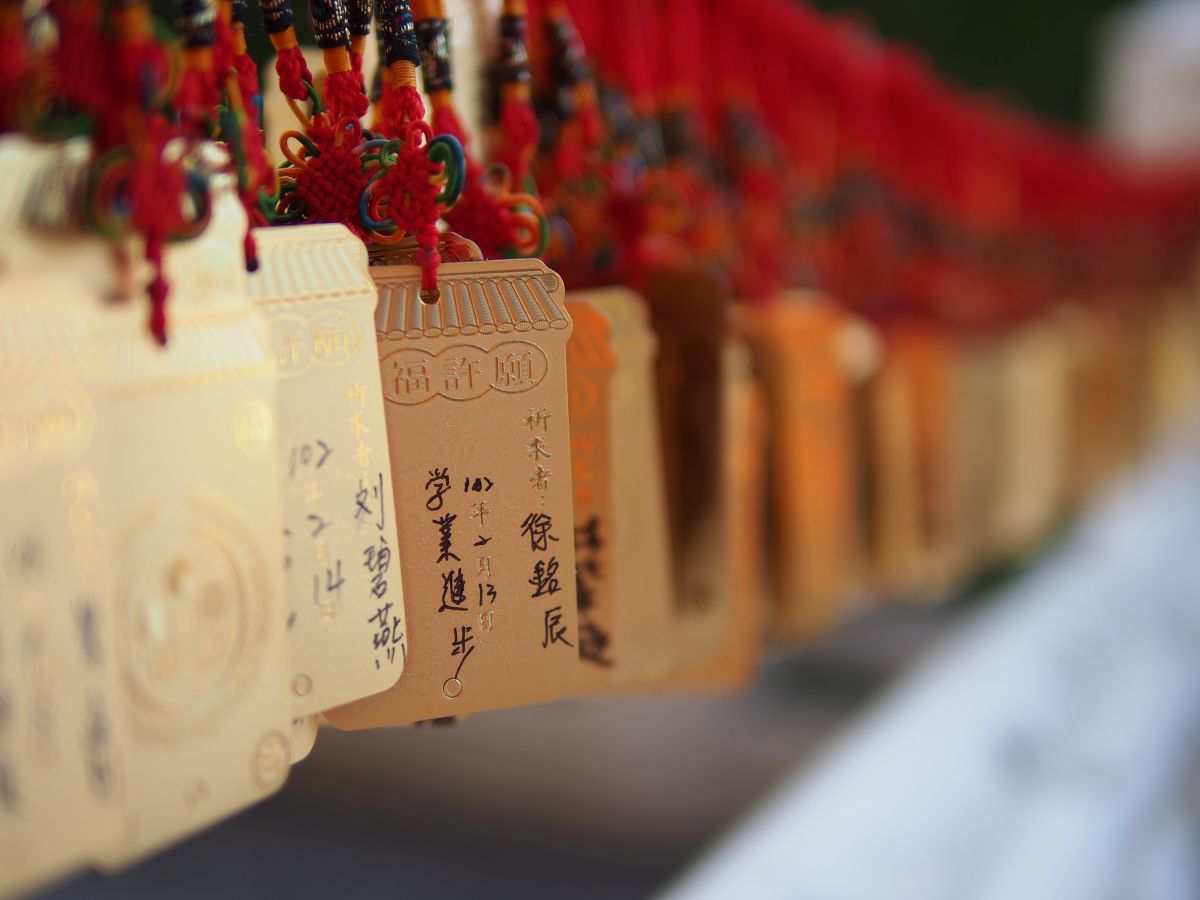 This highway – the central cross-island highway – is one of three that cross the island of Taiwan and go through the central mountain range. A few years ago, a big earthquake destroyed a central portion of this highway and it hasn’t been repaired and it is still closed. I drove through Guguan and then as far as I could go until I reached a checkpoint. It looked like official vehicles were allowed at least a short distance beyond that point, but that was as far as I could go. I had driven down the highway from the other side to the checkpoint on that side, too, so I’d seen as much of the highway and the countryside as is possible.
This highway – the central cross-island highway – is one of three that cross the island of Taiwan and go through the central mountain range. A few years ago, a big earthquake destroyed a central portion of this highway and it hasn’t been repaired and it is still closed. I drove through Guguan and then as far as I could go until I reached a checkpoint. It looked like official vehicles were allowed at least a short distance beyond that point, but that was as far as I could go. I had driven down the highway from the other side to the checkpoint on that side, too, so I’d seen as much of the highway and the countryside as is possible.
Back in Gugaun, I parked my scooter and went for an hour-long hike up into the surrounding mountains. I just wanted to get a view of the area, but the trail didn’t go high enough to give me much of a view. Still, I enjoyed the exercise. I then drove back to the temple, where I settled in for the evening in my wonderful room. I never sleep that well, and I tossed and turned most of the night and made several trips out of my room to the common bathroom down the hall and outside. The skies were clear and I saw a number of stars up there in the black. One never sees stars in Taipei, so it was nice to stand there and take it in.
My plans for today are to drive down out of the central mountain range and then drive north starting my trip back to Taipei. I have today – Friday – and then Saturday and Sunday left on my holidays. My goal is to drive to this little town called Dongshih and then turn deeper into the mountains down some side roads that I’ve got my eye on. My guess is that it is quite remote and beautiful up there. Hopefully, there will be places to stay up there. If not, I still have my tent. Well, it’s late in the day now and it is time to hit the road.
Tags: CNY Scooter Trip Taiwan 2013, incense, scooter, Taiwan, temple

